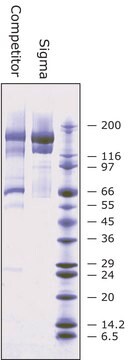M6514
3-(Trimethoxysilyl)propylmethacrylat
≥97%
Synonym(e):
Silan A174, [3-(Methacryloyloxy)propyl]trimethoxysilan
About This Item
Empfohlene Produkte
Qualitätsniveau
Assay
≥97%
Form
liquid
Brechungsindex
n20/D 1.431 (lit.)
bp
190 °C (lit.)
Dichte
1.045 g/mL at 25 °C (lit.)
Lagertemp.
2-8°C
SMILES String
CO[Si](CCCOC(=O)C(C)=C)(OC)OC
InChI
1S/C10H20O5Si/c1-9(2)10(11)15-7-6-8-16(12-3,13-4)14-5/h1,6-8H2,2-5H3
InChIKey
XDLMVUHYZWKMMD-UHFFFAOYSA-N
Suchen Sie nach ähnlichen Produkten? Aufrufen Leitfaden zum Produktvergleich
Allgemeine Beschreibung
Anwendung
- Isoelectric focusing can lead to pH gradient formation resulting in the swelling or shrinking of gel casts. This can be prevented by using 3-(Trimethoxysilyl)propyl methacrylate to link polyacrylamide gels to glass plates covalently.
- In situ hybridization using 3-(Trimethoxysilyl)propyl methacrylate along with poly-L-lysine is a faster and durable method to attach cells, microscopic sections, and total organs to slides/other glass surfaces.
- 3-(Trimethoxysilyl)propyl methacrylate is also used in the preparation of organic/inorganic hybrid nanomaterials.
Verpackung
Ähnliches Produkt
Lagerklassenschlüssel
10 - Combustible liquids
WGK
WGK 1
Flammpunkt (°F)
197.6 °F - closed cup
Flammpunkt (°C)
92 °C - closed cup
Persönliche Schutzausrüstung
Eyeshields, Gloves, type ABEK (EN14387) respirator filter
Analysenzertifikate (COA)
Suchen Sie nach Analysenzertifikate (COA), indem Sie die Lot-/Chargennummer des Produkts eingeben. Lot- und Chargennummern sind auf dem Produktetikett hinter den Wörtern ‘Lot’ oder ‘Batch’ (Lot oder Charge) zu finden.
Besitzen Sie dieses Produkt bereits?
In der Dokumentenbibliothek finden Sie die Dokumentation zu den Produkten, die Sie kürzlich erworben haben.
Kunden haben sich ebenfalls angesehen
Unser Team von Wissenschaftlern verfügt über Erfahrung in allen Forschungsbereichen einschließlich Life Science, Materialwissenschaften, chemischer Synthese, Chromatographie, Analytik und vielen mehr..
Setzen Sie sich mit dem technischen Dienst in Verbindung.






![3-[Tris(trimethylsiloxy)silyl]propylmethacrylat contains MEHQ + HQ as stabilizer, 98%](/deepweb/assets/sigmaaldrich/product/structures/148/664/33ff5116-f264-4a64-824a-009c2ca5b2b3/640/33ff5116-f264-4a64-824a-009c2ca5b2b3.png)


